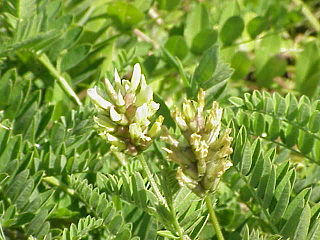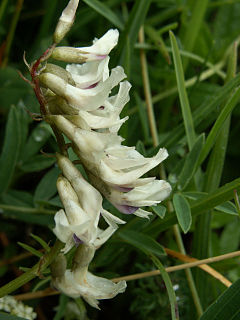
The Fabaceae or Leguminosae, commonly known as the legume, pea, or bean family, are a large and agriculturally important family of flowering plants. It includes trees, shrubs, and perennial or annual herbaceous plants, which are easily recognized by their fruit (legume) and their compound, stipulate leaves. The family is widely distributed, and is the third-largest land plant family in number of species, behind only the Orchidaceae and Asteraceae, with about 765 genera and nearly 20,000 known species.
Locoweed is a common name in North America for any plant that produces swainsonine, a phytotoxin harmful to livestock. Worldwide, swainsonine is produced by a small number of species, most of them in three genera of the flowering plant family Fabaceae: Oxytropis and Astragalus in North America, and Swainsona in Australia. The term locoweed usually refers only to the North American species of Oxytropis and Astragalus, but this article includes the other species as well. Some references may list Datura stramonium as locoweed.

Astragalus is a large genus of over 3,000 species of herbs and small shrubs, belonging to the legume family Fabaceae and the subfamily Faboideae. It is the largest genus of plants in terms of described species. The genus is native to temperate regions of the Northern Hemisphere. Common names include milkvetch, locoweed and goat's-thorn. Some pale-flowered vetches are similar in appearance, but they are more vine-like than Astragalus.

Astragalus alpinus is a species of flowering plant in the legume family known by the common name alpine milkvetch. It has a circumpolar distribution, occurring throughout the upper latitudes of the Northern Hemisphere.

Astragalus propinquus (syn. Astragalus membranaceus, commonly known as Mongolian milkvetch in English; 'Хунчир' in Mongolian; huáng qí, běi qí or huáng huā huáng qí, in Mongolia, is a flowering plant in the family Fabaceae. It is one of the 50 fundamental herbs used in traditional Mongolian medicine. It is a perennial plant and it is not listed as being threatened.

Astragalus nitidiflorus is a species of legume in the family Fabaceae. It is endemic to Cartagena, southeast of Spain. It was refound after about 100 years of extinction and "the reappearance of this species has awakened the interest of environmental managers because the reasons for its critical situation are unknown". In 2004, a group of 46 specimens were discovered in a protected area between Cartagena and Mazarrón and plans for the conservation of this species have been implemented. ISSR markers helped to find that Astragalus nitidiflorus has a low genetic diversity. "This species grows in shallow soil from metamorphic and volcanic rocks in between mountain and cultivated areas".

Astragalus bisulcatus, commonly called two-grooved milkvetch or silver-leafed milkvetch, is a leafy perennial with pea-like flowers. It is native to central and western North America, and typically grows on selenium-rich soils. It accumulates selenium within its tissues, and when livestock consume it, the selenium can be toxic.

Astragalus purshii is a species of milkvetch known by the common names woollypod milkvetch and Pursh's milkvetch.

Astragalus cicer, the chickpea milkvetch, chick-pea milk-vetch or cicer milkvetch, is a perennial flowering plant native to Eastern Europe, popularized and subsequently transported to areas in Southern Europe, North America, and South America. Cicer milkvetch exhibits legume-like qualities; the plant produces pods which harbor its seeds. Its flowers are usually of pale yellow tint, and as such, attract bumble or European honey bees for pollination. Growth often exceeds 0.6 meters, up to a height of 1 meter in length.

Astragalus australis is a species of flowering plant in the legume family known by the common name Indian milkvetch. It is native to much of the Northern Hemisphere, including northern North America, Europe, and temperate Asia.

The flora of Lebanon includes approximately 2,600 plant species. Situated on the eastern coast of the Mediterranean Basin, Lebanon is a reservoir of plant diversity and one of the world's biodiversity hotspots for conservation priorities. Endemic species constitute 12% of the Lebanese flora; 221 plant species are broad endemics and 90 are narrow endemics. Important Plant Areas (IPAs) featuring the country exceptional botanical richness were defined in 2018.
A. ehrenbergii may refer to:

Brachistosternus ehrenbergii is a scorpion species and the most cited species in the genus Brachistosternus. The species was first described by Paul Gervais in 1841. Its venom is toxic to mice.
Galium ehrenbergii is a species of flowering plant in the Rubiaceae family. It was first described by Pierre Edmond Boissier. In 1884, Henry Baker Tristram found G. ehrenbergii in Jisr el Hajar, Lebanon. It is also found in Syria.
Malaxis ehrenbergii, the Ehrenberg's adder's-mouth orchid, is a Mesoamerican species of orchid native to northwestern Mexico. It has been found in Mexico, Guatemala, and El Salvador.

Astragalus danicus, known as purple milk-vetch, is a species of flowering plant in the family Fabaceae (legumes), which is native to Europe.

Astragalus crassicarpus, known as ground plum or buffalo plum, is a perennial species of flowering plant in the legume family, Fabaceae, native to North America. It was described in 1813. The fruit is edible and was used by Native Americans as food and horse medicine. It is a host of afranius duskywing larvae. It is also known as groundplum milkvetch and pomme de prairie.

Astragalus neglectus, or Cooper's milkvetch, is a species of flowering plant in the family Fabaceae native to northeastern North America.
Astragalus racemosus, the cream milkvetch, is a species of flowering plant in the family Fabaceae. It is native to central North America. A selenium hyperaccumulator, it is considered capable of poisoning livestock as one of the locoweeds.













